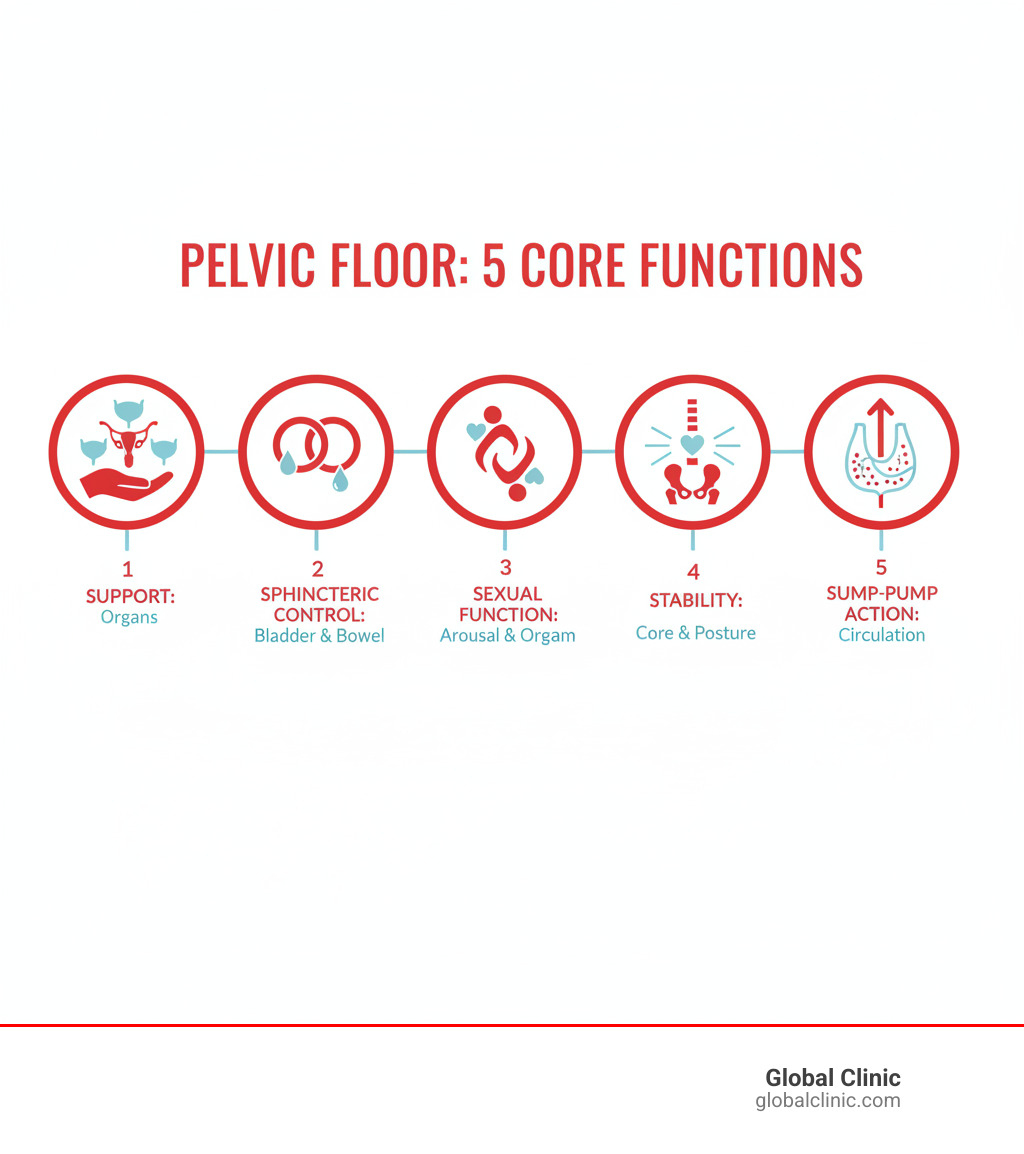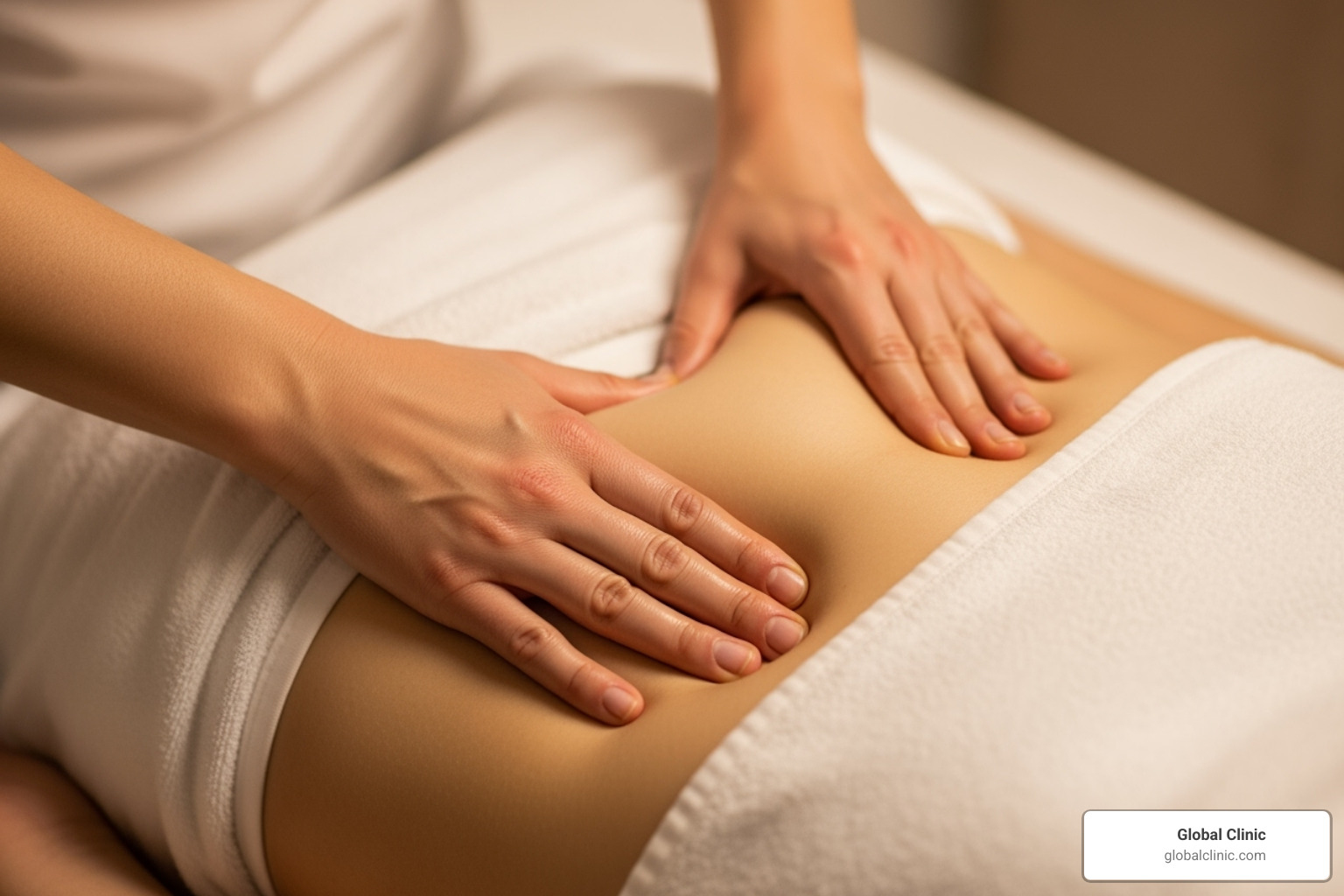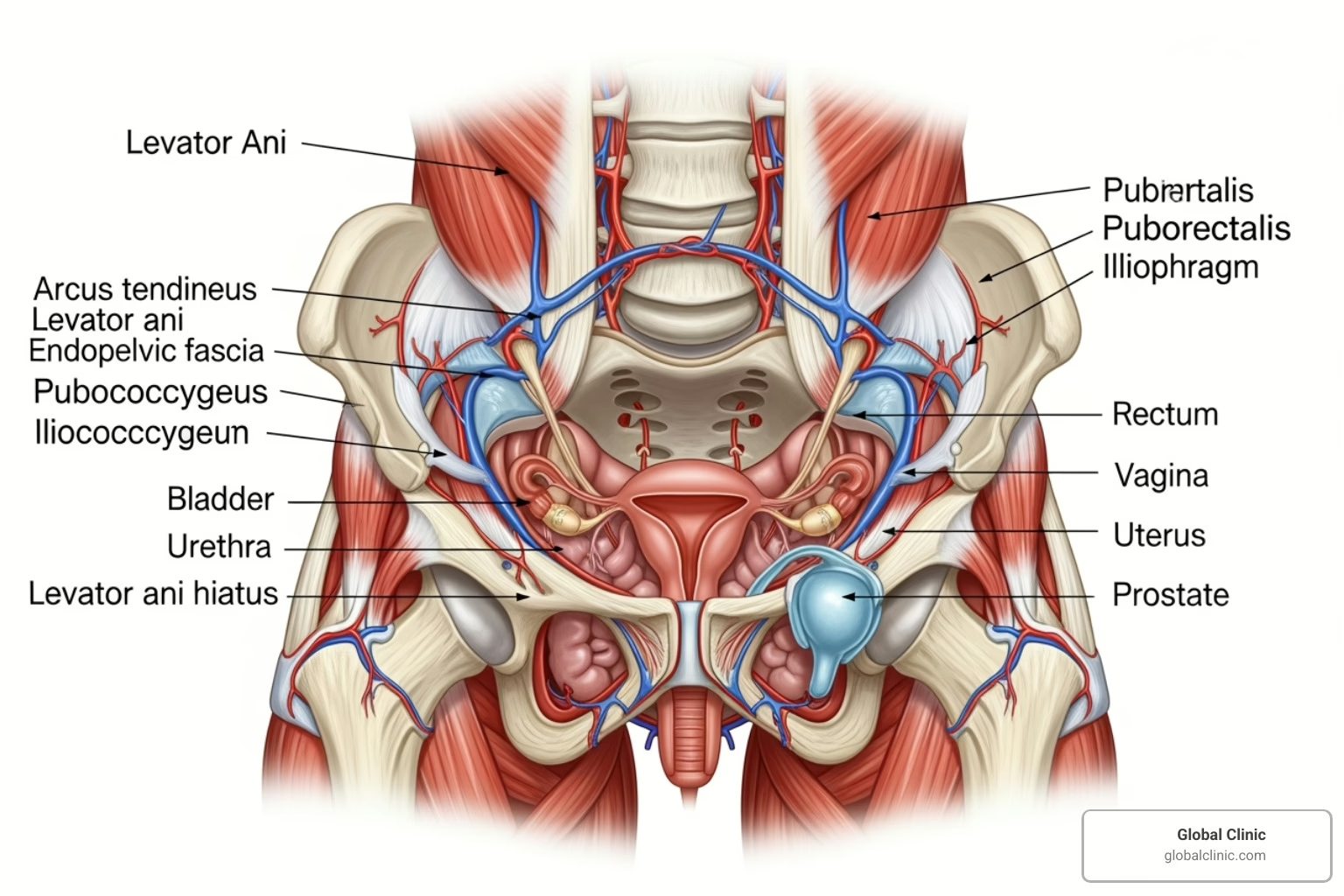What is the Pelvic Floor and Why Does It Matter?
Pelvic floor massage is a therapeutic technique targeting the muscles supporting your pelvic organs. This therapy can address pain and dysfunction that affects millions, yet is often misunderstood.
Quick Overview: What You Need to Know About Pelvic Floor Massage
- What it is: Therapeutic pressure applied to muscles supporting your bladder, bowel, and reproductive organs.
- Who needs it: People with pelvic pain, incontinence, painful intercourse, or postpartum issues.
- Types: External (surrounding muscles) and internal (direct pelvic floor muscles) massage.
- Benefits: Reduces pain, improves blood flow, releases tension, and improves function.
- Safety: Best performed by trained professionals, though self-massage is possible with guidance.
Your pelvic floor is a hammock of muscles stretched between your tailbone and pubic bone. These muscles provide organ support, sphincter control, core stability, and contribute to sexual function and pelvic circulation.
Problems arise when these muscles become too tight (hypertonic) or too weak (hypotonic). While 1 in 3 women experience a pelvic floor disorder, many mistakenly believe their symptoms are normal. They aren’t—and you don’t have to live with them. Both tight and weak muscles can be treated effectively with targeted massage.
I’m Ana Vinikov, Practice Manager at Global Clinic. For over 20 years, I’ve helped patients find relief from complex pain, including conditions requiring pelvic floor massage. Our team addresses the root causes of pelvic dysfunction, not just the symptoms.

Recognizing the Signs: Symptoms and Causes of Pelvic Floor Dysfunction
Your pelvic floor muscles should contract and relax in a coordinated way. When they get stuck in the wrong position—either too tight or too weak—it leads to symptoms that can significantly impact your daily life. Understanding the difference is key to getting the right treatment, including whether pelvic floor massage can help.
Hypertonic (Tight) Pelvic Floor Muscles
When muscles are hypertonic, they are stuck in a contracted state. This can cause a cascade of symptoms:
- Pelvic pain: A deep ache in the lower abdomen, sharp pelvic pains, or tailbone discomfort.
- Painful intercourse (dyspareunia): Tight muscles can make vaginal penetration difficult or impossible.
- Bowel and bladder issues: Constipation is common because tight muscles make it hard to have a complete bowel movement. You might also experience urinary urgency, frequency, or painful urination.
- Lower back and hip pain: Tension in the pelvic floor can radiate, contributing to pain in connected areas and sometimes mimicking conditions like Piriformis Syndrome vs. Sciatica.
Hypotonic (Weak) Pelvic Floor Muscles
A weak pelvic floor lacks the strength to properly support your organs or control your sphincters.
- Urinary incontinence: Leaking urine when you cough, sneeze, or laugh (stress incontinence), or sudden, strong urges to urinate (urge incontinence).
- Fecal incontinence: Difficulty controlling gas or bowel movements.
- Pelvic organ prolapse: The bladder, uterus, or rectum may descend into the vaginal canal, creating feelings of pressure or bulging.
- Chronic lower back pain: Weak pelvic muscles contribute to core instability, a common issue for new mothers experiencing postpartum back pain.
Common Causes of Pelvic Floor Dysfunction
Pelvic floor issues can affect anyone. Common causes include childbirth, aging, and hormonal changes like menopause. Pelvic surgery, chronic strain from heavy lifting or coughing, pelvic trauma, and even chronic stress and anxiety can all contribute to dysfunction.
| Symptom | Tight Pelvic Floor | Weak Pelvic Floor |
|---|---|---|
| Pelvic Pain | Deep ache, sharp pain, painful intercourse | Sometimes due to lack of support |
| Urinary Issues | Urgency, frequency, painful urination | Leaking with cough/sneeze, dribbling |
| Bowel Issues | Constipation, straining, incomplete emptying | Difficulty controlling gas or bowel movements |
| Sexual Function | Painful intercourse, muscle spasms | Reduced sensation, difficulty with orgasm |
| Pressure/Bulging | Less common | Pelvic organ prolapse |
| Back/Hip Pain | Yes, due to muscle tension | Yes, due to lack of core stability |
Recognizing these symptoms is the first step toward getting effective treatment and reclaiming your comfort.
A Guide to Pelvic Floor Massage Techniques
Pelvic floor massage acts like a reset button for muscles that are too tight or weak. The technique helps restore function by increasing blood flow, promoting muscle relaxation, releasing stubborn trigger points (knots), and reducing pain signals by calming the nervous system. This process of sensory integration retrains the body to accept touch as healing. Manual therapy, including pelvic floor massage, is a valuable tool for managing chronic pelvic pain, as confirmed by research in the Cochrane Library.

External Massage for Pelvic Pain Relief
Therapy often begins with external pelvic floor massage, as the pelvic floor is connected to muscles in the hips, glutes, and abdomen. Tightness in these surrounding areas can pull on the pelvic floor and create dysfunction.
We use myofascial release to target the fascia (connective tissue) around muscles. Applying gentle, sustained pressure to areas like the glutes, hip flexors, and abdominal muscles can release tension. For example, releasing tight hip flexors can allow the pelvis to return to a neutral position, relieving strain on the pelvic floor. This approach aligns with our methods for addressing back pain with physical therapy, as pelvic health is foundational to spinal stability. External massage also serves as a great warm-up for internal work.
Understanding Internal Pelvic Floor Massage
Internal pelvic floor massage allows a therapist to work directly on muscles inside the pelvic bowl. While it may sound intimidating, it is a highly effective and well-tolerated technique when performed by a trained professional. Using a gloved, lubricated finger, the therapist can gently assess and treat tight muscle bands and trigger points inside the vagina or rectum that are otherwise unreachable.
We often use a clock-face analogy (pubic bone at 12, tailbone at 6) to communicate which areas are being treated. Water-based lubricant is essential for comfort. Some people use pelvic wands for self-treatment at home, but professional instruction is recommended first. As noted by Harvard Health, pelvic physical therapy with internal techniques is an effective treatment for many pelvic floor conditions.
How to Perform Self-Pelvic Floor Massage at Home
With guidance from a therapist, self-massage can be a valuable maintenance practice.
- Preparation: Wash your hands and find a comfortable, relaxed position, such as lying on your back with knees bent. Take several deep, diaphragmatic breaths to help your pelvic floor muscles soften. Use a generous amount of water-based lubricant.
- External Massage: Use your thumb to apply gentle, circular pressure to the perineum (the area between your vaginal opening and anus). You can also gently stretch this tissue. Massage any tender spots in your inner thighs and glutes.
- Internal Massage: Insert one lubricated finger about 1-2 inches into your vagina. Gently explore for tender spots, particularly along the sides (3 and 9 o’clock positions), avoiding direct pressure on the urethra (11 to 1 o’clock). When you find a tender spot, apply gentle, sustained pressure for 30-90 seconds while breathing deeply. It should feel like a “good hurt,” not sharp pain.
- Safety First: Always start with light pressure and listen to your body. If you feel sharp pain, stop. A pelvic floor physical therapist can provide personalized guidance for safe and effective self-massage.
Your Path to Recovery: The Role of Physical Therapy and Complementary Exercises
While pelvic floor massage provides significant relief, the best results come from a comprehensive treatment plan guided by a specialist. At Global Clinic, our pelvic floor physical therapists have specialized training to understand the intricate connections between your pelvic floor, breathing, and posture.

Our comprehensive assessment examines how your entire body works together, as the key to pelvic dysfunction can sometimes lie in hip tension or breathing patterns. We then create a personalized treatment plan that may include massage, specific exercises, and education to empower you in your recovery.
What to Expect During Your First Pelvic Floor Physical Therapy Session
Your first visit is a safe space to discuss your health concerns. It begins with an in-depth conversation about your symptoms, lifestyle, and goals. This is followed by a movement and postural assessment of your back, hips, and abdomen to identify related issues.
An internal assessment may be recommended, but it only happens with your full consent. This gentle, functional exam helps your therapist understand your muscle tone, strength, and coordination. It is not like a standard gynecological exam; you remain in control throughout the process. 1 in 3 women experience pelvic floor disorders, and effective treatment is available.
Essential Pelvic Floor Exercises and Stretches
- Child’s Pose: Kneel with big toes touching and knees wide, then fold forward. This pose gently lengthens and relaxes the pelvic floor.
- Happy Baby Pose: Lie on your back and grab the outsides of your feet, opening your knees wider than your torso. This releases the inner thighs and pelvic floor.
- Piriformis Stretch: Lie on your back with knees bent. Cross one ankle over the opposite knee and gently pull the bottom knee toward your chest to stretch the glute. This can relieve pain linked to pelvic floor issues, a connection we often see when Addressing Back Pain with Physical Therapy.
Exercises for a Tight Pelvic Floor
For tight muscles, the focus is on relaxation and lengthening.
- Diaphragmatic Breathing: Breathe deep into your belly. As you inhale, your diaphragm and pelvic floor should gently descend; as you exhale, they rise. This retrains coordination.
- Reverse Kegels: Instead of squeezing, focus on actively releasing and lengthening the pelvic floor muscles, as if letting go of urine.
- Gentle Stretching: Regularly practice the poses listed above to encourage muscles to release chronic tension.
Exercises for a Weak Pelvic Floor
For weak muscles, the goal is to build strength and coordination.
- Kegels: Squeeze and lift your pelvic floor muscles as if stopping the flow of urine, hold for a few seconds, and then completely relax. The relaxation phase is crucial.
- Bridges: Lie on your back with knees bent. Exhale, engage your pelvic floor and glutes, and lift your hips. Inhale as you slowly lower down, relaxing the pelvic floor.
- Squats: Inhale and relax your pelvic floor as you lower into a squat. Exhale and gently engage your pelvic floor as you stand up. This trains muscles for real-life movements.
Always remember the ‘3 E’s’ principle: Exhale on Effort while Engaging your core and pelvic floor.
Frequently Asked Questions about Pelvic Floor Therapy
It’s natural to have questions about pelvic floor massage and therapy. As a practice manager at Global Clinic for over two decades, I’ve addressed many common concerns from our patients in Northern Chicago.
How do I know if my pelvic floor is tight or weak?
It can be difficult to self-diagnose, as some symptoms overlap. Generally, a tight pelvic floor is associated with chronic pelvic pain, painful intercourse, constipation, and urinary urgency or frequency. A weak pelvic floor typically leads to urinary or fecal incontinence (leaking) and a feeling of heaviness or bulging in the pelvis.
The most reliable way to know for sure is a comprehensive assessment with a specialized pelvic floor physical therapist. They can perform an internal exam to evaluate your muscle tone and strength, which allows us to create a treatment plan that addresses your specific needs.
Is pelvic floor massage painful?
Pelvic floor massage should not be painful when performed correctly by a trained professional. You might feel sensitivity or discomfort when we work on tight trigger points, similar to a deep tissue massage. However, it should feel like a “good hurt” that brings relief, not sharp pain.
Your comfort is our priority. We encourage constant communication, and you are always in control. We can adjust pressure or techniques at any time. For those with hypersensitivity, gentle massage can even help retrain the nervous system to associate touch with comfort instead of pain.
How long does it take to see results from pelvic floor therapy?
Recovery time varies for each person. It depends on the severity and duration of your symptoms, the underlying causes, and your commitment to your home exercise program. Patients who are consistent with their exercises between sessions often see the fastest results.
Some people feel improvement within a few sessions. For more chronic conditions, we tell patients to expect about three months of consistent work to see significant, lasting changes. We are retraining muscles and movement patterns that have been dysfunctional for a long time. Your journey is unique, and we will work with you to set realistic goals and celebrate your progress.
Conclusion: Taking the Next Step in Your Pelvic Health Journey
Your journey to better pelvic health is one you don’t have to take alone. While self-care is important, real change happens when you commit to professional care.

Consistency is key to recovery. Integrating breathing exercises, stretches, and pelvic floor massage techniques into your daily routine helps change ingrained muscle patterns. This mind-body connection is crucial, as your pelvic floor responds to stress and emotions. Approaching your healing with patience and self-compassion nurtures your whole self back to wellness.
At Global Clinic, we’ve spent over 20 years perfecting our personalized approach to pain management in Northern Chicago. We don’t use cookie-cutter plans. Instead, we combine innovative techniques with genuine care to address the root causes of your discomfort.
Whether you’re in Arlington Heights, Barrington, Crystal Lake, Des Plaines, Elk Grove Village, Glenview, or any of the surrounding communities we serve, relief is within reach. Our experienced pelvic floor specialists are ready to guide you with evidence-based treatments, from pelvic floor massage to custom exercise programs.
You deserve to live without pain or dysfunction. These conditions are not something you have to accept—they are treatable.
Take control of your health with our Pelvic Floor Physical Therapy services and find what life feels like when your pelvic floor is working with you, not against you.


